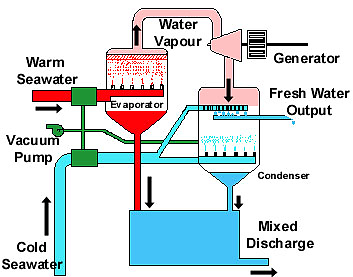A short while ago, the Delft Energy Club organized a Master Class on ocean energy. The Delft Energy Club is a student-run platform with energy as its core business. They strive to contribute in the transition towards sustainable energy by connecting students, academics and professionals. This particular event was one of many that they organized, and this time I was there to see what the ocean has on offer for us in terms of energy potential.
The day was filled with presentations about different types of energy conversion from the ocean. Things like harnessing the power of tides and waves came along. One example showed the use of an underwater "kite" of some sort, which continually moves in an 8-shaped path and thereby powers a small turbine. Fascinating! However, the technology that interested me the most was one called OTEC. OTEC stands for Ocean Thermal Energy Conversion. It makes use of the temperature difference between the upper layer of the ocean and of that around a kilometer below, where the temperatures are much lower. Apparently, a temperature difference of 20 degrees should be enough to steadily create power.
There are a few interesting characteristics about this technology that I would like to share. First of all, currently solar- and wind power can more or less be considered to have become "mainstream" sustainable energy production technologies. However, I guess not many people realize that large scale integration of these technologies comes with a big challenge: unpredictability and so-called "intermittency". This means that the source of power fluctuates: a wind park does not produce a steady and constant stream of electricity every hour, nor does a solar panel (the latter does not create any power at all during the night). You can imagine that this makes it very hard for power companies to match the hourly production of electricity with the hourly demand, because they do not know exactly how much wind will be available every day. As a result, there is need for either expensive storage facilities that can capture excess power and release it when production is lower than demand. Or (and this is the current scenario) there is still need for fossil fuel based generators that can easily be turned on and off to meet the demand fluctuations (in The Netherlands, we use natural gas plants for this). The beauty about OTEC is that it is not a "seasonal" technology: it can provide a steady flow of electricity all day and all night long, making it useful as a so-called "base load" generator.
The second nice feature about OTEC is that with small design changes, it can not only produce power, but also clean drinking water. How cool is that? This is especially great for isolated communities such as islands, where producing energy and food prices are generally quite expensive because fuels and clean water need to be imported. This new technology can be a big step in making such island communities more self sufficient in the future.
Unfortunately for Texel, though, this technology will likely not be very useful for them. The North Sea is not a very warm sea, especially in the winter. So the temperature difference there is too low. At the moment, OTEC is only potentially interesting around the equator, where the water is warm throughout the year. Perhaps wave energy is more suitable for Texel, however this does not solve the intermittency problem I'm afraid. Perhaps OTEC will be further developed in the future, making it efficient enough to also work with lower temperatures. Keep an eye out for this amazing technology!
